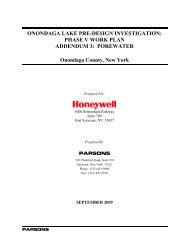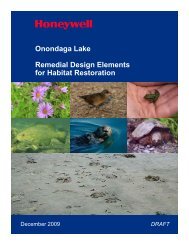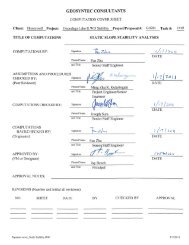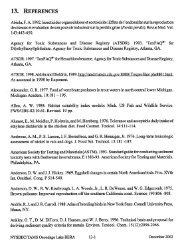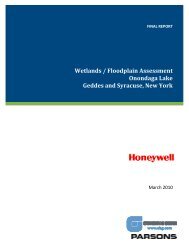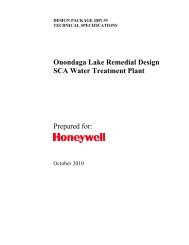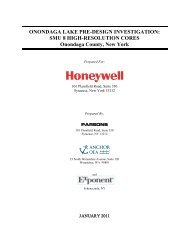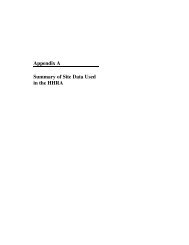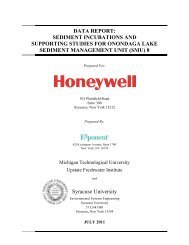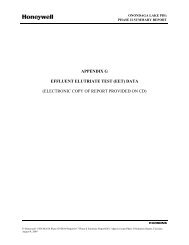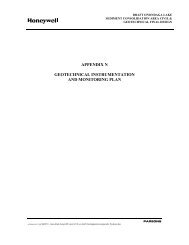Phase 1B Underwater Archaeological Report for the Onondaga ...
Phase 1B Underwater Archaeological Report for the Onondaga ...
Phase 1B Underwater Archaeological Report for the Onondaga ...
You also want an ePaper? Increase the reach of your titles
YUMPU automatically turns print PDFs into web optimized ePapers that Google loves.
FINAL<br />
<strong>Phase</strong> IB <strong>Underwater</strong> <strong>Archaeological</strong> Resources <strong>Report</strong> <strong>for</strong> <strong>Onondaga</strong> Lake Superfund Site<br />
EVALUATION OF NATIONAL REGISTER ELIGIBILITY<br />
A key component of this archaeological study is <strong>the</strong> evaluation of each archaeological site’s significance<br />
in relation to its eligibility <strong>for</strong> <strong>the</strong> National Register of Historic Places. The NRHP is <strong>the</strong> official list of <strong>the</strong><br />
Nation's historic places worthy of preservation. The National Park Service provides guidelines <strong>for</strong><br />
assessing a historic property’s NRHP eligibility. A site is recommended as NRHP eligible if it is more than<br />
50 years old, possesses integrity and meets one or more of <strong>the</strong> criteria considerations.<br />
Integrity is <strong>the</strong> ability of a property to convey its significance. An evaluation of a property’s integrity is<br />
assessed based on an analysis of <strong>the</strong> seven aspects or qualities that define integrity. These concepts are:<br />
Location is <strong>the</strong> place where <strong>the</strong> historic property was constructed or <strong>the</strong> place where <strong>the</strong> historic<br />
event occurred.<br />
Design is <strong>the</strong> combination of elements that create <strong>the</strong> <strong>for</strong>m, plan, space, structure, and style of a<br />
property.<br />
Setting is <strong>the</strong> physical environment of a historic property.<br />
Material are <strong>the</strong> physical elements that were combined or deposited during a particular periods<br />
of time and in a particular pattern or configuration to <strong>for</strong>m a historic property.<br />
Workmanship is <strong>the</strong> physical evidence of <strong>the</strong> crafts of a particular culture or people during any<br />
given period in history or prehistory.<br />
Feeling is a property’s expression of <strong>the</strong> aes<strong>the</strong>tic or historic sense of a particular period of time.<br />
Association is <strong>the</strong> direct link between an important historic event or person and a historic<br />
property. 116<br />
In addition to having integrity, a property must also meet at least one of <strong>the</strong> NRHP’s criteria<br />
considerations. The criteria include:<br />
A. Sites that are associated with events that have made a significant contribution to <strong>the</strong> broad<br />
patterns of our history; or<br />
B. that are associated with <strong>the</strong> lives of persons significant in our past; or<br />
C. that embody <strong>the</strong> distinctive characteristics of a type, period, or method of construction, or<br />
that represent <strong>the</strong> work of a master, or that possess high artistic value, or that represent a<br />
significant and distinguishable entity whose components may lack individual distinction; or<br />
D. that have yielded, or may be likely to yield, in<strong>for</strong>mation important in prehistory or history. 117<br />
The National Park Service has produced numerous bulletins designed to provide technical in<strong>for</strong>mation<br />
on <strong>the</strong> survey, evaluation, registration and preservation of cultural properties as it pertains to <strong>the</strong> NRHP.<br />
The bulletins used in <strong>the</strong> evaluation of <strong>Onondaga</strong> Lake’s submerged cultural properties include: How to<br />
Apply <strong>the</strong> National Register Criteria <strong>for</strong> Evaluation, 118 Guidelines <strong>for</strong> Evaluation and Registering<br />
Archeological Properties, 119 Guidelines <strong>for</strong> Evaluating and Documenting Historic Aids to Navigation, 120<br />
Nominating Historic Vessels and Shipwrecks to <strong>the</strong> National Register of Historic Places, 121 and Guidelines<br />
<strong>for</strong> Evaluating and Registering Historical <strong>Archaeological</strong> Sites and Districts. 122<br />
47



